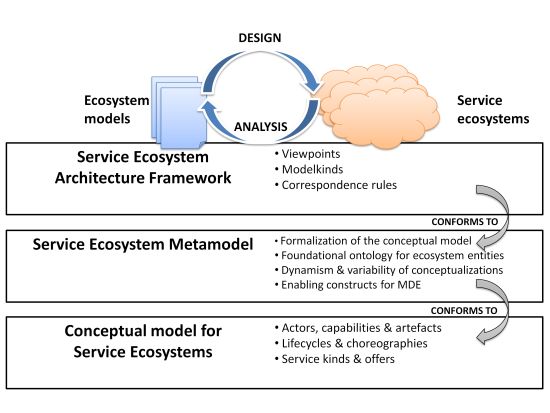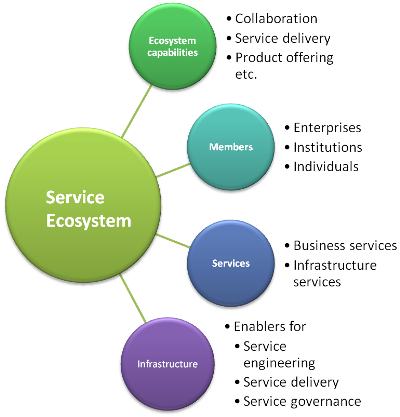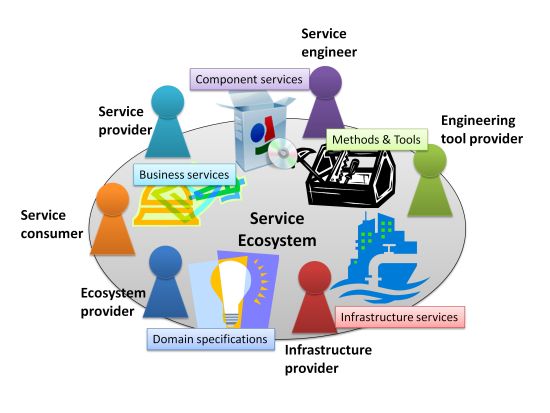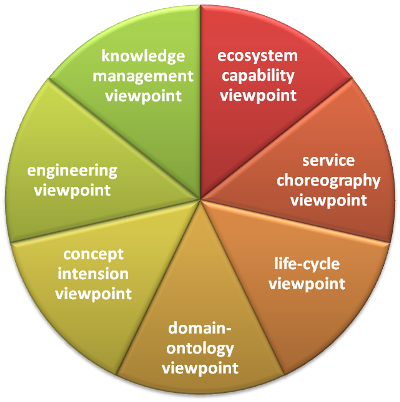Overview

This web site introduces service ecosystem engineering, a novel systems engineering discipline for enabling a transition from contemporary ad hoc service ecosystems to sustainable ones. Such a transition is required for supporting modern networked business practices and the “services everywhere” vision.
The service ecosystem engineering discipline is realized with a model-driven approach. The approach facilitates establishment of sustainable service ecosystems where service ecosystem viability is achieved by addressing the characteristic concerns of ecosystem stakeholders. Means for analysing, designing and applying explicit service ecosystem architecture models are provided. The approach is founded on three components:
- a conceptual model for open service ecosystems
- a service ecosystem meta-model, and
- the Service Ecosystem Architecture Framework (SEAF).
The model-driven approach for service ecosystem engineering is developed in the PhD dissertation of Toni Ruokolainen (available here).
Service ecosystems
The passage from monolithic, product-driven business models to networked and service-based business has given rise to the emergence of service ecosystems. A service ecosystem is a socio-technical complex system that enables service-based collaborations between entities such as enterprises, institutions or individuals. Service ecosystems may emerge spontaneously due to a common interest or demand, or as a result of long-term strategic planning. Examples of service ecosystems include software ecosystems, electronic business networks, cloud computing platforms and social networking platforms.
Contemporary service ecosystems are now challenged especially on two fronts. On one hand, networked business and networked business models require support especially for efficient business decision making, opportunistic and flexible business networking and service ecosystem governance. Such activities require explicit knowledge about the capabilities and other characteristics of service ecosystems. On the other hand, the visions of Internet of Things and Internet of Services necessitate means for efficient, on-demand establishment of domain-specific service ecosystems, as well as loosely coupled connectivity and interoperability both in and between distinct service ecosystems. Due to the implicit nature of contemporary service ecosystem architectures, and technology-driven engineering processes the current service ecosystems are at risk to become yet new technological and conceptual silos.
Elements of service ecosystems
Service-centric business takes place in varying kinds of service ecosystems. A service ecosystem is a socio-technical complex system that enables service-based collaboration between autonomous entities such as enterprises, institutions and individuals.

Click on the image parts on the left for descriptions!
The ecosystem provides an environment for creating and managing service-based collaboration networks, such as virtual organizations or service mash-ups, from services provided by a community of autonomous entities.
An ecosystem capability is the ability of a service ecosystem to perform actions. An ecosystem capability provides a declaration of core functionality in the service ecosystems. A set of ecosystem capabilities describes the motive for ecosystem existence, or the ecosystem purpose. Ecosystem capabilities include service delivery and collaboration, for example. In product-centric service ecosystems a capability of product provisioning is the primary motive for the ecosystem operation.
Ecosystem members are autonomous entities such as enterprises, institutions or individuals which act in the service ecosystem in specific roles. An entity is considered as an object of the ecosystem with an identity and that has its own distinct existence. Entities bound to a role must possess the capability of discharging the commitments a role imposes for them.
A service is considered as a mechanism to access one or more capabilities. A service is realized by an exchange of value objects between a service consumer and a service provider. A value object is created, traded, and consumed by ecosystem entities and is of economic, ideological, political or social value for at least one of the entities involved. From an economic perspective, services are considered as intangible, perishable, inseparable, and variable goods, as opposed to products
Ecosystem infrastructure provides means for realizing service engineering, service delivery and service ecosystem governance activities in the service ecosystem. In addition to infrastructure services, ecosystem infrastructure includes a) service engineering tools and methods, b) specifications of ecosystem features and feature bindings, and c) cooperation facilities enabling dependable service interactions and communication. Service ecosystem governance is enabled with infrastructure services which coordinate cooperation between ecosystem members in accordance to ecosystem life cycles
Stakeholders
Service ecosystem stakeholders include service consumers, service providers, service engineers, engineering tool providers, infrastructure providers, and ecosystem providers. Service consumers are legal entities that utilize business services available in the ecosystem to fulfill their business needs.

Click on the image part for descriptions!
Service consumers are responsible for utilizing the business services as declared in agreements made with service providers about service utilization. Service consumers may confront challenges related to identification and selection of suitable business services, dependability of business services, and monitoring of business service operations.
Service providers are legal entities that offer business services for their clientele. In a business landscape comprising diverse service ecosystems, service provider differentiation and revenue is created by providing added value for the customers. Service providers act in service ecosystems for creating profit by optimizing their business service usage, and supporting their business models. The services consumed by the clientele may directly benefit the business of the service provider. Services can also be provided for creating support and added value for other products, or for establishing and promoting business platforms around the offered services.
Service engineers produce so-called component services by implementing technological artefacts (e.g. web services) which are then utilized by service providers to implement their business services. The primary concern of service engineers is that of well-advised service engineering. Well-advised service engineering here refers to both correspondence of service engineering with the business models (“well-advised motivations”) and pragmatics (“well-advised practices”) of the ecosystem.
Engineering tool providers are responsible for providing service engineers with tools. For increasing the efficiency of service production in a service ecosystem, the tools should be specialized for the specific domain of operation. Consequently, the primary concern of engineering tool providers in service ecosystems is efficient tool production and specialization.
Infrastructure providers deliver infrastructure services required by service ecosystems. Delivering infrastructure services could be business on its own, or it might be affordable due to supporting other aspects of infrastructure provider business models (e.g. bootstrapping the use of business services in the service ecosystem). Thus, efficiency of infrastructure service production becomes a concern for infrastructure providers.
Ecosystem providers represent entities such as organizations or consortia whose business models require utilization and instrumentation of a service ecosystem. Ecosystem providers initiate establishment of service ecosystems by first analyzing and designing required ecosystem capabilities, and identifying means for delivering those capabilities. The primary concerns associated with ecosystem providers are analysis and design of service ecosystems, and enabling and maintaining ecosystem viability by service ecosystem governance.
Thesis
My PhD thesis proposes service ecosystem engineering as a novel systems engineering discipline. There are three main contributions in the dissertation.
First, the means for a rigorous service ecosystem engineering is provided. Service ecosystem engineering is defined as a systems engineering life cycle which comprises phases of ecosystem analysis, design, instrumentation and operation. Rigour for all these phases is provided with creation and utilization of explicit service ecosystem architecture models.
Secondly, instruments for supporting service ecosystem sustainability are delivered. Service ecosystem sustainability is supported with a model-driven approach that addresses the identified stakeholder concerns in the different phases of service ecosystem engineering.
Thirdly, means for managing interoperability and engineering knowledge in open service ecosystems are provided. These contributions in concert enable establishment of sustainable and open service ecosystems.
Validation and evaluation of the model-driven approach for service ecosystem engineering comprises several assessments. The feasibility of the approach is validated by assessing the technical implementability of the individual artefacts. The applicability of the approach is validated with respect to the practical usability of the artefacts for service ecosystem analysis, design and instrumentation. For this purpose a case study is conducted where a stateof-the-art service ecosystem is first modelled. The resulting service ecosystem architecture model is then utilized within the model-driven methodology for service ecosystem instrumentation. The research method followed in this dissertation is design science whose goal is to provide utility for system stakeholders. The utility of the approach is evaluated with respect to the needs of service ecosystem stakeholders and requirements stemming from the definition of service ecosystem sustainability and vision of open service ecosystems.
The thesis is available here:
Service ecosystem meta-model
The service ecosystem meta-model elaborates and formalizes the conceptual model defined in the PhD thesis and enables instrumentation of service ecosystem sustainability. Especially, the meta-model provides support for continuation of viability and enables model-based management and governance of service ecosystem operation. Such management and governance facilities are required especially in open service ecosystems for guaranteeing correctness of ecosystem operation and establishing interoperability between autonomous members. More over, formal ecosystem architecture models support unification and integration of separate enterprise) systems and even different service ecosystems. This decreases especially the risk of building conceptual and technological stove-pipe systems, since the designs of service ecosystems are explicit and, as such, mappable to other formal system designs (other service ecosystem designs).
There are two foundational requirements that affect the design of the service ecosystem meta-model. First of all, the conceptual model for service ecosystems must be formalized by the meta-model for establishing consistency of service ecosystem architecture descriptions, as well as for enabling rigorous service ecosystem design and analysis. Secondly, design principles for the meta-model need to reflect the requirements implied by service ecosystem sustainability and the vision of open service ecosystems.
The service ecosystem meta-model was designed with UML Class diagram notation. For the purpose of applying the meta-model in the model-driven approach for service ecosystem engineering, the UML-based meta-model description was transformed to Eclipse Modeling Framework Ecore model.
Service Ecosystem Architecture Framework
The Service Ecosystem Architecture Framework (SEAF) facilitates rigorous service ecosystem engineering by providing means for service ecosystem analysis and design based on explicit and formal architecture models. Explicit service ecosystem architecture models are needed for enabling efficient architecture analysis and design practices, assessment of architectural properties with respect to design principles, and traceability of design decisions, for example.

Click on the image for descriptions!
The engineering viewpoint frames the concern of enabling well-advised and efficient service engineering in service ecosystems. Well-advised and efficient service engineering is supported by prescribing reusable engineering assets and following a situational method engineering approach. Engineering assets include definitions for product models and binding models.
Product models pre-scribe artefacts and their compositions appropriate to be utilized in service engineering methods. Typically the decompositions of artefacts would follow the structure of knowledge items, but other kinds of structuring allowing more efficient engineering efforts can also be utilized. Methods are composed of method chunks which are autonomous and coherent parts of methods. Binding models declare the rules for late encapsulation of services with bindable features: binding specifications prescribe what kinds of features can be bound to service roles, business transactions or service connections, for example.
